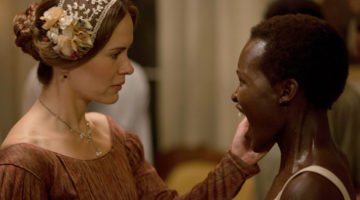A Conversation with Oscar-winning Costume Designer Sandy Powell
Three-time Oscar winner Sandy Powell is one of the most sought after costume directors in the business. When Martin Scorsese isn’t keeping her busy, she is creating some of the most beautiful costumes to grace the screen. This year, Powell adds Carol and Cinderella to her filmography that already includes films such as The Aviator, The Crying Game, Shakespeare in Love, and The Young Victoria. Working with Todd Haynes she has done the costumes for Velvet Goldmine, Far From Heaven, and now his latest hit Carol. We spoke to Powell to discuss Carol, Scorsese, and why contemporary films never get in on the award season glory for their costumes.
Scene Creek: In one sequence Carol wears a red coat that is very similar to the one worn by Julianne Moore’s Cathy in Far From Heaven. Did you look back on your designs when you’re working on films from a similar period such as Carol and Far From Heaven?
Sandy Powell: No, not at all. Not consciously anyway. Far From Heaven was late ’50s and this is early ’50s, but they’re quite different really. Far From Heaven was ’57 and this is ’52 and in ’52 most people are still looking like the 1940’s where by ’57 the ’40s have sort of gone away, with the exception of very old people. Also, the whole look and feel of this film, even though it’s the 50’s was different. Far From Heaven was actually quite stylized and heightened in that in was an homage to Douglas Sirk, and the whole Technicolor thing. This one was a lot grittier and grainier and cooler in tone. I would never have consciously looked back over old things. We wanted it to contrast. Though sometimes you do find that you repeat things. I might repeat combinations of colours, just because it’s something I gravitate towards or like. There have been times – not in this project – I discovered I used the same fabric on two costumes on films years apart and didn’t realize until I saw both the costumes standing next to each other in an exhibition. It was unintentional, but sometimes you do these things unconsciously.
SC: I find it interesting that you mentioned using cool colours, because there’s a coolness in tone to this film. Not just from the costumes but the cinematography, with the grain from the 16mm film…
SP: It’s also set in winter. It’s set in winter and shot in winter. This was the palette that Todd intended. It would have looked very odd with the cinematography and the settings and the landscape if it had strongly coloured people in there.
SC: There’s such a harmony to it. Everything is so in line. From the direction, to the cinematography, to the acting and the costumes, no one is out of step.
SP: I do agree. That’s something that happens very rarely, and when it does you know that’s what makes a great film. When every little element comes together, I think that’s down to the director ultimately. Choosing the right combination of people and also being very capable of communication. Todd is a very great communicator, especially at communicating his vision. That is very important. All directors have a vision but not all of them have the ability to communicate what exactly is in their head. Some director’s don’t know what they want until they see it, which is another way of working. Todd has a very clear vision and he has a very clear way of communicating it in that he presented everybody with a look book at the beginning of all the images that were in his head, all the references that he was using. Everything that inspired and influenced him he showed us. So you get a head start. When I see the film and then look back at the original look book, it is incredible how they’re both the same.
SC: Isn’t the look book usually something that you would create as well?
SP: Yes, of course. He starts off with his, and then I build up my own reference book. I do sort of general imagery. I usually do it scene by scene for different kinds of people and later by character. I use different images I respond to for different characters. Whether it’s specific items of clothing or sometimes it’s just a feeling. It can be something rather abstract. Then I show that to Todd and we discuss it.
SC: Were there any characters in this film that you had more difficulty dressing?
SP: Not at all. I’m sad there’s not more of the Sarah Paulson character Abby, because we did original have a lot more things for her and I actually really enjoyed doing her character, which was much different than the other two. Sadly a lot of her looks got left behind. There just wasn’t enough time in the film to put everything in. But no, I didn’t have that many difficulties, because there really aren’t that many characters to do. Really it boils down to the two main parts and then the subsidiary characters. I think that’s also down to casting. The casting was extremely spot on and sometimes you just see the actor and know. Like the character Dannie. You read the script and you might think one thing, but then you meet the actor John Magaro and then suddenly his look comes to me and I know what he should be wearing. It’s a lot like that.
SC: This is your third film with Todd. Another director you’ve worked with many times is Martin Scorsese, who you’ve done six films with. How does working with those two directors differ, especially considered how vastly different their films are?
SP: They are! Interestingly, they’re both very similar to work with, because they’re both incredibly visual and incredibly bright. They both respond to visuals. Marty likes to do lots of research. He has an entire department dedicated full time to doing research. So at the beginning of working on a film with him you are presented with a whole bunch of material to begin with, which again is incredibly helpful. Marty also understands and enjoys clothes in the same way Todd does. It really helps working with a director that likes costumes and likes clothes. There are some directors that don’t have such great interest in the clothes and just let me get on with it, which is fine. It’s more satisfying to work with directors who enjoy discussing it really.
SC: When you won your third Oscar for The Young Victoria, you dedicated the award to the designers who work on films besides period dramas and musicals who often fail to get recognized. Five years later, has nothing changed?
SP: It really hasn’t. It’s almost always a period of a fantasy film that wins the awards. Of the period films it’s usually the biggest and most colourful. It’s usually really historical stuff, like deep history about monarchs. It’s the biggest and the boldest. The smaller films, like Carol for instance, aren’t so showy, and absolutely always contemporary films don’t get recognized because I think people don’t think that contemporary films are designed, where of course they are. It’s really interesting. Designing means making decisions, it doesn’t necessarily mean to sit down and draw a picture and making a costume. It means making a decision about what somebody is wearing to tell their story, to make their character come to life, and that’s what our job is. It’s not about making people pretty; it’s about making the characters completely and utterly believable. So that character in a contemporary film…it has to be believable that they’ve chosen those clothes to wear that day, or they’ve picked them up off the floor and put what they had on last night. There’s a skill to that, there’s a skill to making that look real. That goes unrecognized. I think there are still people who believe that actors come in their own clothes in contemporary films. I don’t do many of them; I find them really hard.
SC: Why is that?
SP: It’s difficult because everybody has an opinion about contemporary wardrobe actually [laughs]. It’s kind of harder to nail something down. All I can say is that the designers who excel at that go unnoticed because usually a good contemporary film means that you haven’t really noticed the clothes. If they haven’t stood out and you haven’t noticed them, they’ve done a really great job because it means that everything is completely believable. You’re not getting distracted thinking that an outfit looks completely brand new. They have to be made to look like real, wearable, worn clothes.




